Yuexin Wu
MIND: A Multi-agent Framework for Zero-shot Harmful Meme Detection
Jul 09, 2025Abstract:The rapid expansion of memes on social media has highlighted the urgent need for effective approaches to detect harmful content. However, traditional data-driven approaches struggle to detect new memes due to their evolving nature and the lack of up-to-date annotated data. To address this issue, we propose MIND, a multi-agent framework for zero-shot harmful meme detection that does not rely on annotated data. MIND implements three key strategies: 1) We retrieve similar memes from an unannotated reference set to provide contextual information. 2) We propose a bi-directional insight derivation mechanism to extract a comprehensive understanding of similar memes. 3) We then employ a multi-agent debate mechanism to ensure robust decision-making through reasoned arbitration. Extensive experiments on three meme datasets demonstrate that our proposed framework not only outperforms existing zero-shot approaches but also shows strong generalization across different model architectures and parameter scales, providing a scalable solution for harmful meme detection. The code is available at https://github.com/destroy-lonely/MIND.
Distilling Text Style Transfer With Self-Explanation From LLMs
Mar 02, 2024



Abstract:Text Style Transfer (TST) seeks to alter the style of text while retaining its core content. Given the constraints of limited parallel datasets for TST, we propose CoTeX, a framework that leverages large language models (LLMs) alongside chain-of-thought (CoT) prompting to facilitate TST. CoTeX distills the complex rewriting and reasoning capabilities of LLMs into more streamlined models capable of working with both non-parallel and parallel data. Through experimentation across four TST datasets, CoTeX is shown to surpass traditional supervised fine-tuning and knowledge distillation methods, particularly in low-resource settings. We conduct a comprehensive evaluation, comparing CoTeX against current unsupervised, supervised, in-context learning (ICL) techniques, and instruction-tuned LLMs. Furthermore, CoTeX distinguishes itself by offering transparent explanations for its style transfer process.
Multi-step Problem Solving Through a Verifier: An Empirical Analysis on Model-induced Process Supervision
Feb 05, 2024



Abstract:Process supervision, using a trained verifier to evaluate the intermediate steps generated by reasoner, has demonstrated significant improvements in multi-step problem solving. In this paper, to avoid expensive human annotation effort on the verifier training data, we introduce Model-induced Process Supervision (MiPS), a novel method for automating data curation. MiPS annotates an intermediate step by sampling completions of this solution through the reasoning model, and obtaining an accuracy defined as the proportion of correct completions. Errors in the reasoner would cause MiPS to underestimate the accuracy of intermediate steps, therefore, we suggest and empirically show that verification focusing on high predicted scores of the verifier shall be preferred over that of low predicted scores, contrary to prior work. Our approach significantly improves the performance of PaLM 2 on math and coding tasks (accuracy +0.67% on GSM8K, +4.16% on MATH, +0.92% on MBPP compared with an output supervision trained verifier). Additionally, our study demonstrates that the verifier exhibits strong generalization ability across different reasoning models.
Enable Language Models to Implicitly Learn Self-Improvement From Data
Oct 05, 2023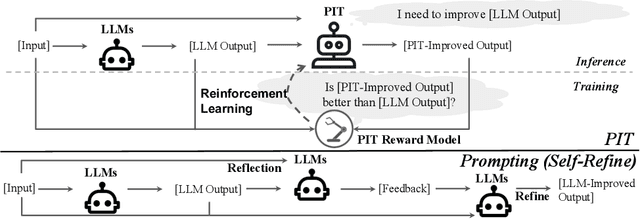
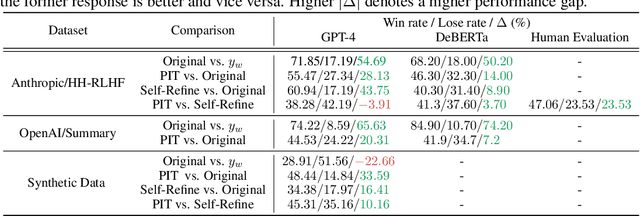
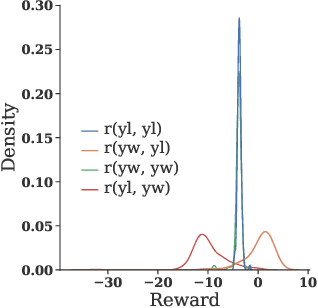

Abstract:Large Language Models (LLMs) have demonstrated remarkable capabilities in open-ended text generation tasks. However, the inherent open-ended nature of these tasks implies that there is always room for improvement in the quality of model responses. To address this challenge, various approaches have been proposed to enhance the performance of LLMs. There has been a growing focus on enabling LLMs to self-improve their response quality, thereby reducing the reliance on extensive human annotation efforts for collecting diverse and high-quality training data. Recently, prompting-based methods have been widely explored among self-improvement methods owing to their effectiveness, efficiency, and convenience. However, those methods usually require explicitly and thoroughly written rubrics as inputs to LLMs. It is expensive and challenging to manually derive and provide all necessary rubrics with a real-world complex goal for improvement (e.g., being more helpful and less harmful). To this end, we propose an ImPlicit Self-ImprovemenT (PIT) framework that implicitly learns the improvement goal from human preference data. PIT only requires preference data that are used to train reward models without extra human efforts. Specifically, we reformulate the training objective of reinforcement learning from human feedback (RLHF) -- instead of maximizing response quality for a given input, we maximize the quality gap of the response conditioned on a reference response. In this way, PIT is implicitly trained with the improvement goal of better aligning with human preferences. Experiments on two real-world datasets and one synthetic dataset show that our method significantly outperforms prompting-based methods.
Flan-MoE: Scaling Instruction-Finetuned Language Models with Sparse Mixture of Experts
May 24, 2023Abstract:The explosive growth of language models and their applications have led to an increased demand for efficient and scalable methods. In this paper, we introduce Flan-MoE, a set of Instruction-Finetuned Sparse Mixture-of-Expert (MoE) models. We show that naively finetuning MoE models on a task-specific dataset (in other words, no instruction-finetuning) often yield worse performance compared to dense models of the same computational complexity. However, our Flan-MoE outperforms dense models under multiple experiment settings: instruction-finetuning only and instruction-finetuning followed by task-specific finetuning. This shows that instruction-finetuning is an essential stage for MoE models. Specifically, our largest model, Flan-MoE-32B, surpasses the performance of Flan-PaLM-62B on four benchmarks, while utilizing only one-third of the FLOPs. The success of Flan-MoE encourages rethinking the design of large-scale, high-performance language models, under the setting of task-agnostic learning.
Token Imbalance Adaptation for Radiology Report Generation
Apr 18, 2023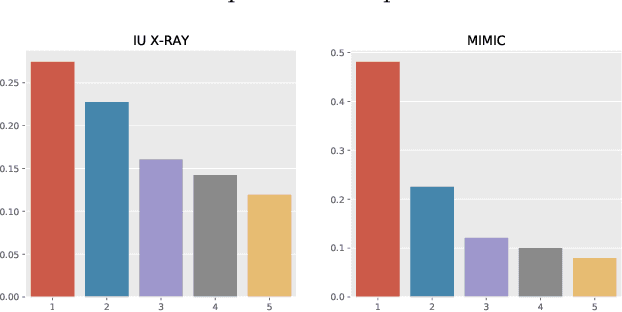

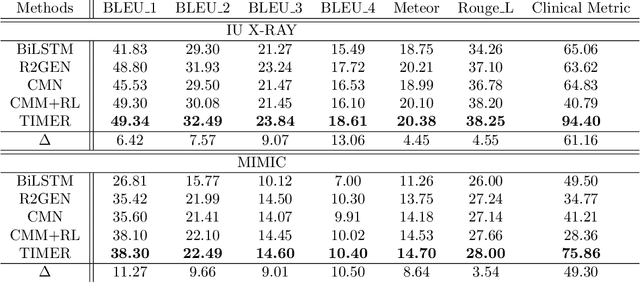
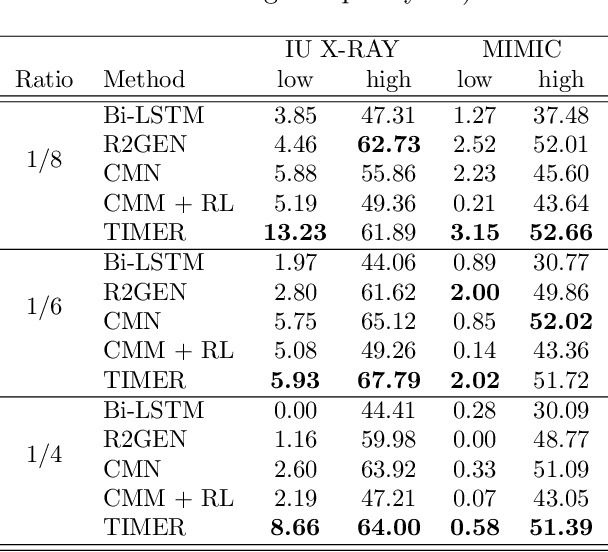
Abstract:Imbalanced token distributions naturally exist in text documents, leading neural language models to overfit on frequent tokens. The token imbalance may dampen the robustness of radiology report generators, as complex medical terms appear less frequently but reflect more medical information. In this study, we demonstrate how current state-of-the-art models fail to generate infrequent tokens on two standard benchmark datasets (IU X-RAY and MIMIC-CXR) of radiology report generation. % However, no prior study has proposed methods to adapt infrequent tokens for text generators feeding with medical images. To solve the challenge, we propose the \textbf{T}oken \textbf{Im}balance Adapt\textbf{er} (\textit{TIMER}), aiming to improve generation robustness on infrequent tokens. The model automatically leverages token imbalance by an unlikelihood loss and dynamically optimizes generation processes to augment infrequent tokens. We compare our approach with multiple state-of-the-art methods on the two benchmarks. Experiments demonstrate the effectiveness of our approach in enhancing model robustness overall and infrequent tokens. Our ablation analysis shows that our reinforcement learning method has a major effect in adapting token imbalance for radiology report generation.
Conditional Adapters: Parameter-efficient Transfer Learning with Fast Inference
Apr 11, 2023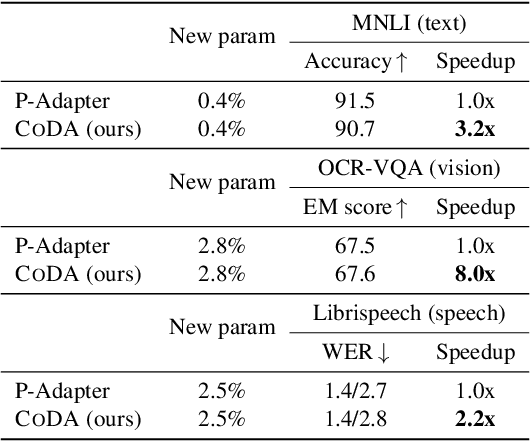
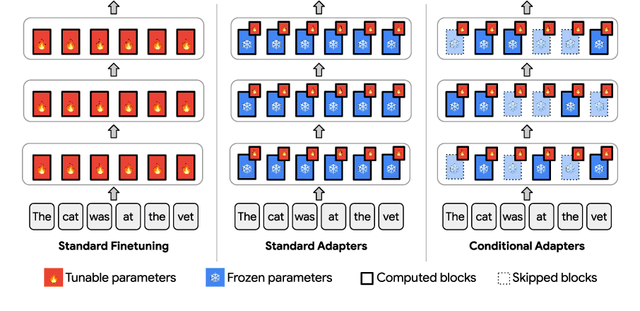
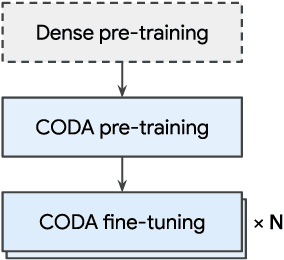

Abstract:We propose Conditional Adapter (CoDA), a parameter-efficient transfer learning method that also improves inference efficiency. CoDA generalizes beyond standard adapter approaches to enable a new way of balancing speed and accuracy using conditional computation. Starting with an existing dense pretrained model, CoDA adds sparse activation together with a small number of new parameters and a light-weight training phase. Our experiments demonstrate that the CoDA approach provides an unexpectedly efficient way to transfer knowledge. Across a variety of language, vision, and speech tasks, CoDA achieves a 2x to 8x inference speed-up compared to the state-of-the-art Adapter approach with moderate to no accuracy loss and the same parameter efficiency.
Unsupervised Reinforcement Adaptation for Class-Imbalanced Text Classification
May 26, 2022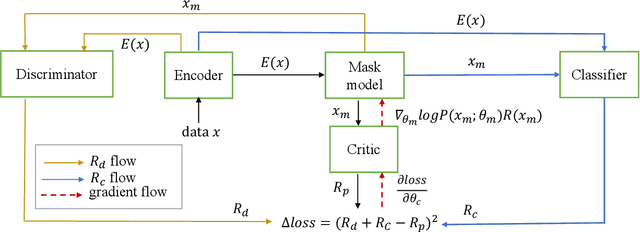
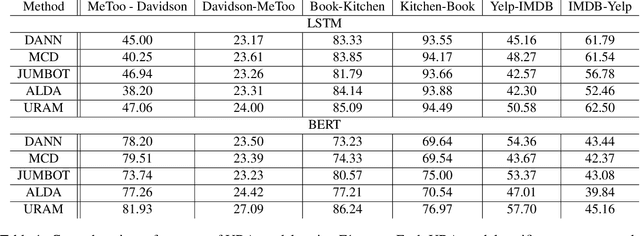

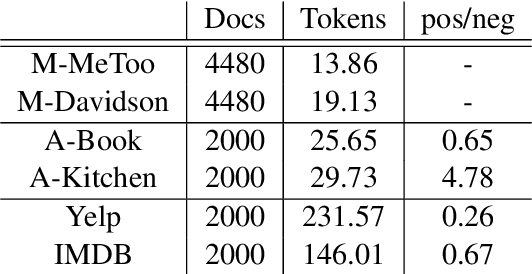
Abstract:Class imbalance naturally exists when train and test models in different domains. Unsupervised domain adaptation (UDA) augments model performance with only accessible annotations from the source domain and unlabeled data from the target domain. However, existing state-of-the-art UDA models learn domain-invariant representations and evaluate primarily on class-balanced data across domains. In this work, we propose an unsupervised domain adaptation approach via reinforcement learning that jointly leverages feature variants and imbalanced labels across domains. We experiment with the text classification task for its easily accessible datasets and compare the proposed method with five baselines. Experiments on three datasets prove that our proposed method can effectively learn robust domain-invariant representations and successfully adapt text classifiers on imbalanced classes over domains. The code is available at https://github.com/woqingdoua/ImbalanceClass.
Token Dropping for Efficient BERT Pretraining
Mar 24, 2022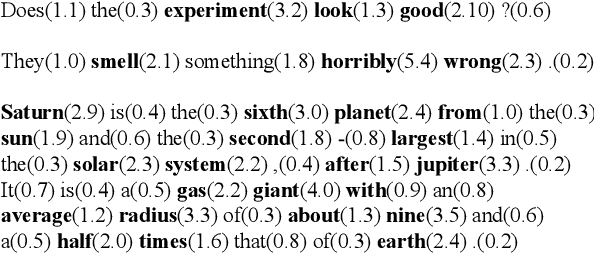
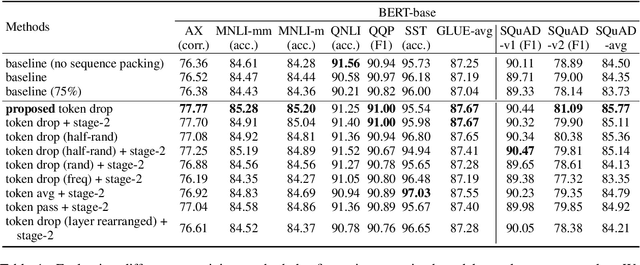
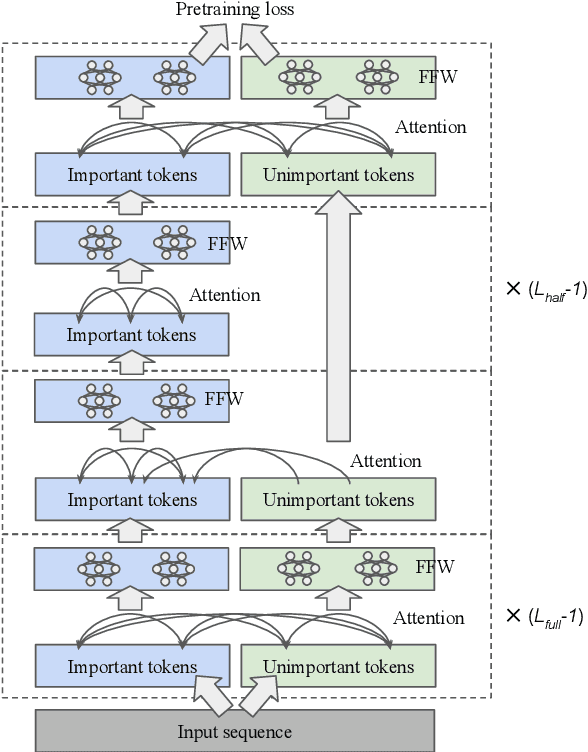
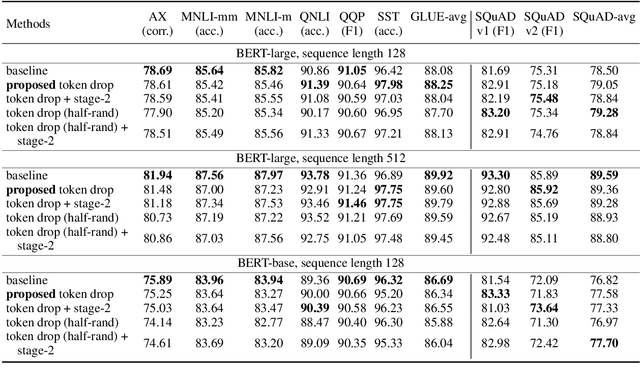
Abstract:Transformer-based models generally allocate the same amount of computation for each token in a given sequence. We develop a simple but effective "token dropping" method to accelerate the pretraining of transformer models, such as BERT, without degrading its performance on downstream tasks. In short, we drop unimportant tokens starting from an intermediate layer in the model to make the model focus on important tokens; the dropped tokens are later picked up by the last layer of the model so that the model still produces full-length sequences. We leverage the already built-in masked language modeling (MLM) loss to identify unimportant tokens with practically no computational overhead. In our experiments, this simple approach reduces the pretraining cost of BERT by 25% while achieving similar overall fine-tuning performance on standard downstream tasks.
Provable Stochastic Optimization for Global Contrastive Learning: Small Batch Does Not Harm Performance
Feb 24, 2022



Abstract:In this paper, we study contrastive learning from an optimization perspective, aiming to analyze and address a fundamental issue of existing contrastive learning methods that either rely on a large batch size or a large dictionary. We consider a global objective for contrastive learning, which contrasts each positive pair with all negative pairs for an anchor point. From the optimization perspective, we explain why existing methods such as SimCLR requires a large batch size in order to achieve a satisfactory result. In order to remove such requirement, we propose a memory-efficient Stochastic Optimization algorithm for solving the Global objective of Contrastive Learning of Representations, named SogCLR. We show that its optimization error is negligible under a reasonable condition after a sufficient number of iterations or is diminishing for a slightly different global contrastive objective. Empirically, we demonstrate that on ImageNet with a batch size 256, SogCLR achieves a performance of 69.4% for top-1 linear evaluation accuracy using ResNet-50, which is on par with SimCLR (69.3%) with a large batch size 8,192. We also attempt to show that the proposed optimization technique is generic and can be applied to solving other contrastive losses, e.g., two-way contrastive losses for bimodal contrastive learning.
 Add to Chrome
Add to Chrome Add to Firefox
Add to Firefox Add to Edge
Add to Edge